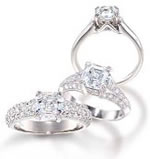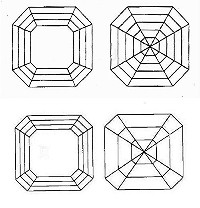 The world-famous diamond cutter, Asscher Diamond Company, established in 1854, patented the Royal Asscher Cut in 2001. It is a version of the hundred year old Asscher Cut. The Royal Asscher Cut diamond is a squarish step-cut style with 74 facets and is the result of computer technology and ancient cutting secrets. “It took two years to develop the software to design the cut,” says the company’s Edward Asscher. It takes up to three months to train technicians to perfect it. Royal Asscher cuts are branded with the company logo, certificate and guarantee plus a certificate from the Gemological Institute of America. GIA designed a special line diagram for the certificates.
The world-famous diamond cutter, Asscher Diamond Company, established in 1854, patented the Royal Asscher Cut in 2001. It is a version of the hundred year old Asscher Cut. The Royal Asscher Cut diamond is a squarish step-cut style with 74 facets and is the result of computer technology and ancient cutting secrets. “It took two years to develop the software to design the cut,” says the company’s Edward Asscher. It takes up to three months to train technicians to perfect it. Royal Asscher cuts are branded with the company logo, certificate and guarantee plus a certificate from the Gemological Institute of America. GIA designed a special line diagram for the certificates.
 Abraham Asscher designed this cut in 1902 and fourth generation of Asscher diamantaires, Edward and Joop Asscher, updated and reintroduced the patented cut. The Asscher Diamond Company now markets the Royal Asscher Cut as the only authentic successor to the original Asscher-cut. The only wholesale distributor of Royal Asschers in the United States is Royal Asscher® of America located in New York.
Abraham Asscher designed this cut in 1902 and fourth generation of Asscher diamantaires, Edward and Joop Asscher, updated and reintroduced the patented cut. The Asscher Diamond Company now markets the Royal Asscher Cut as the only authentic successor to the original Asscher-cut. The only wholesale distributor of Royal Asschers in the United States is Royal Asscher® of America located in New York.
Royal Asschers have the following characteristics in common with the traditional Asschers:
- High crown
- Small table
- Deep and slightly bulging pavilion
- Wide cut corners
- Wide windmill shaped reflection
- House of mirrors (concentric square patterns)
 The original Asscher cut was designed to improve the brilliance of emerald cuts. The Royal Asscher Cut (top facet pattern) retains the original features (small table, high crown and steep pavilion), but has wider corners and more pavilion step facets for added brightness and more sparkle than the original Asscher (bottom facet pattern) in a cut already known to blaze with light. The Royal Asscher tends to have table percentages under 60% while traditional Asschers have a broader range. The stones are cut and polished exclusively in Amsterdam by the Asscher family.
The original Asscher cut was designed to improve the brilliance of emerald cuts. The Royal Asscher Cut (top facet pattern) retains the original features (small table, high crown and steep pavilion), but has wider corners and more pavilion step facets for added brightness and more sparkle than the original Asscher (bottom facet pattern) in a cut already known to blaze with light. The Royal Asscher tends to have table percentages under 60% while traditional Asschers have a broader range. The stones are cut and polished exclusively in Amsterdam by the Asscher family.
 The facet plan on a Royal Asscher is arranged to pull light deep into the stone, creating a spiral effect often likened to the undulating ripples that emanate from a small stone tossed into the center of a glassy pool. Unlike brilliant cuts, whose sole purpose is to repel light, the Royal Asscher is meant to capture the singular beauty, originality and personality of each individual stone, drawing the eye endlessly within it.
The facet plan on a Royal Asscher is arranged to pull light deep into the stone, creating a spiral effect often likened to the undulating ripples that emanate from a small stone tossed into the center of a glassy pool. Unlike brilliant cuts, whose sole purpose is to repel light, the Royal Asscher is meant to capture the singular beauty, originality and personality of each individual stone, drawing the eye endlessly within it.
Be careful when shopping for Royal Asschers that the extra 16 facets warrant the 30% to 80% price premiums over traditional Asscher cut diamonds. If you want a look similar to the Royal Asscher but a price you can afford, look for a traditional Asscher cut with four rows of facets on the pavilion, table percentages of 60% or less and depth percentages in the 65% to 70% range.
